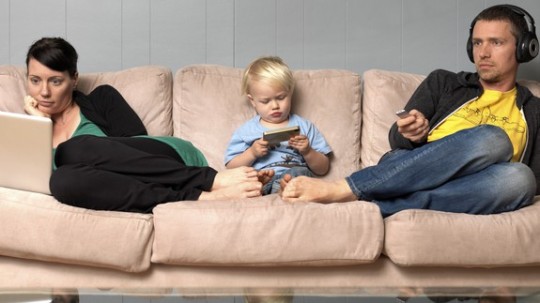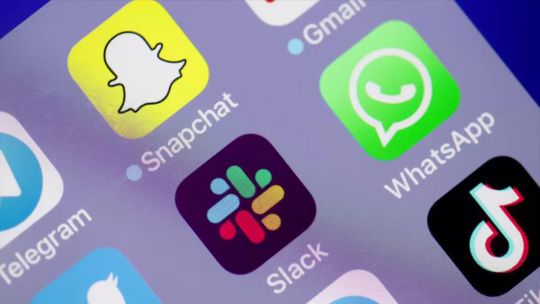#_uuid:26b1be42-0331-309b-8021-c239f979c60c
Text
We're all second-screening. Here's how you're doing it wrong.

Second-screening — watching TV while also looking at your phone, tablet or laptop — is probably the most widely adopted destructive behavior of the decade. We keep hearing that it's bad for us; we keep doing it regardless. It's the smoking of the 2010s.
Psychologists were sounding the alarm as early as 2012 that this kind of screen-based multitasking seemed to be correlated with depression and anxiety. Did we listen? Did we hell. Back then, according to Nielsen, a mere (!) 40 percent of American adults looked at their phones or tablets every day while parked in front of the tube. By 2017, according to eMarketer, that number had climbed to over 70 percent.
The same study anticipated that second-screening would afflict 76 percent of us by 2019; looking around our living rooms now, that figure seems too conservative.
SEE ALSO: Dear significant others: Please let us watch our shows alone
"It relaxes me," my wife says, slightly defensively, when I catch her playing a mobile game rather than paying attention to our show. And really, who am I to judge? Many's the time I've thumbed through Twitter in the dull moments of a so-so episode. No one could be faulted for trying to hide from the commercial break by plunging into their phones instead.
Let he who has never second-screened cast the first stone.
So if we all do it, perhaps it's time to acknowledge that — and instead of wagging hypocritical fingers at each other, try to limit our second-screening in sensible ways that can help head off the worst, most anxiety-inducing aspects. Here's a look at the ways we're doing it right and wrong.
RIGHT: Stay on topic
Probably the most positive use case for second-screening is breaking news. Cable channels can give you one stream of information on a fast-developing story, the internet can provide another, and the two together make you less quick to jump to wrong conclusions.
When you've got multiple sources agreeing on the details of any still-murky event, you're doing news right.
With one eye on the news anchor and a thumb on Twitter, you're less likely to feel useless in the face of the latest unspeakable tragedy. You can donate, you can write to your representatives, you can motivate and console friends. A 2015 paper on "Second Screen Use and Its Effect on Online Political Participation" reached the conclusion that it actually makes us better, more engaged citizens.
The record high youth voter turnout in the 2018 midterm election, the most recent test of our activist second-screen culture, certainly did not disprove this theory.
But you don't have to be saving the world from your couch to feel good about second-screening. The psychological toll (not to mention the IQ-dropping effect!) of multi-tasking seems to derive from the effort of making our brain pay attention to two disparate topics at once.
If you're looking up the answers to questions brought about by the show, or live-tweeting it, you're going to have a better time than if you're just randomly browsing Instagram or scrolling anxiously through your email.
The early 2010s saw a brief flurry of interest in official second-screen apps specifically designed for popular shows, such as ABC's Grey's Anatomy Sync. That app has since vanished from app stores — possibly because it was redundant, given Twitter's ability to host all kinds of conversations, but more likely because Big TV realized that most of us aren't second-screening that way.
According to that eMarketer study, 131.5 million U.S. adults were looking at unrelated content on their phones and tablets while watching TV; just 46.2 million were browsing something related.
Be smart. Be one of the 46.2 million.
WRONG: Don't do it tired
There is, my wife the expert suggests, a limited pool of mental energy available for second-screening. The research on multitasking would seem to back this up, although we probably need more specific research on second-screening itself.
But anecdotally, I think we all know this to be true. Second-screen for too long, or do it too late in the evening, and you end up in a kind of mindless zombie second-screening situation. One where, if you were suddenly asked at any given moment what was happening on either of the screens, you might be hard pressed to answer. Where has your mind gone?
Our current global epidemic of sleeplessness is at least partly caused by the blue glow of LED screens. There's also a second-order effect involved: our obstinate insistence at bathing in two screens at once, too close to bedtime.
RIGHT: Stay alert for ads

An unsuspecting family about to be lured in by marketing.
Image: Getty Images/Hero Images
The zombified nature of the worst kind of second-screening may also be responsible for another trend: we are ridiculously receptive to advertising when we're doing it.
That's partly because we're in more of a position to follow up on a TV ad if we have a device in our hands already. A 2018 study found the average viewer is 75 percent more likely to search for the product if they're second-screening, and that you're even more likely to do so if you're over 40.
But it also works the other way around — in terms of the screen and in terms of generations. A more recent study by Aki Technologies found that viewers were 59 percent more receptive to mobile ads if they're second-screening, moreso if they're millennials.
In other words, the more screens we use, the more advertisers and marketers have us right where they want us. Far be it for a journalist to decry this state of affairs and bite the hand that feeds us, but we should at least be aware that it's happening — not just to us, but to our kids too.
WRONG: Doing it alone

Pick a screen, dude.
Image: Getty Images/Maskot
Second-screening makes a kind of sense for couples and families. It surfs the fine line between together time and alone time without you having to move from the couch. Your significant other can watch their favorite show while you catch up on work, indulge a good old-fashioned Facebook session, or maybe even — whisper it low — read a book.
But if you're flying solo, there's less of an excuse — and more of a possibility that you're just using multiple screens as a substitute for sociability. Are you getting that bright zombified buzz from being bathed in completely disparate kinds of media at once? Maybe pick a lane and stay in it.
Better yet, invite a bunch of introverted friends over, specifically for second-screening purposes. The lure of alone time together is stronger than you might think.
RIGHT: Stay connected
Even if you and your partner/family are all on the couch together, there is a right and a wrong way to second-screen.
Everyone's mileage differs on this, depending on your ideal level of physical affection. Personally, I'd argue that second-screening without some form of snuggling is no kind of second-screening at all. Holding hands while staring at different devices, occasional squeeze included, is a good way to remind each other that you're present, no matter how deep your internet rabbit hole has gone.
The other element of second-screen connection to consider is this: are you creating a safe, warm, happy space for conversation? Can anyone look up from their device at any given moment and say what's on their mind? Or are you hushing them, or dramatically rolling your eyes when you have to hit the pause button to hear them out?
I'm occasionally guilty of the latter. But it's important to remember, especially in our digital age, there is literally nothing we can't put down or pause for a chat. Humans come first.
No matter how many screens you have around you, remember: they come second.
WATCH: Report says popular apps are silently recording your screen

#_author:Chris Taylor#_category:yct:001000002#_uuid:26b1be42-0331-309b-8021-c239f979c60c#_lmsid:a0Vd000000DTrEpEAL#_revsp:news.mashable
0 notes